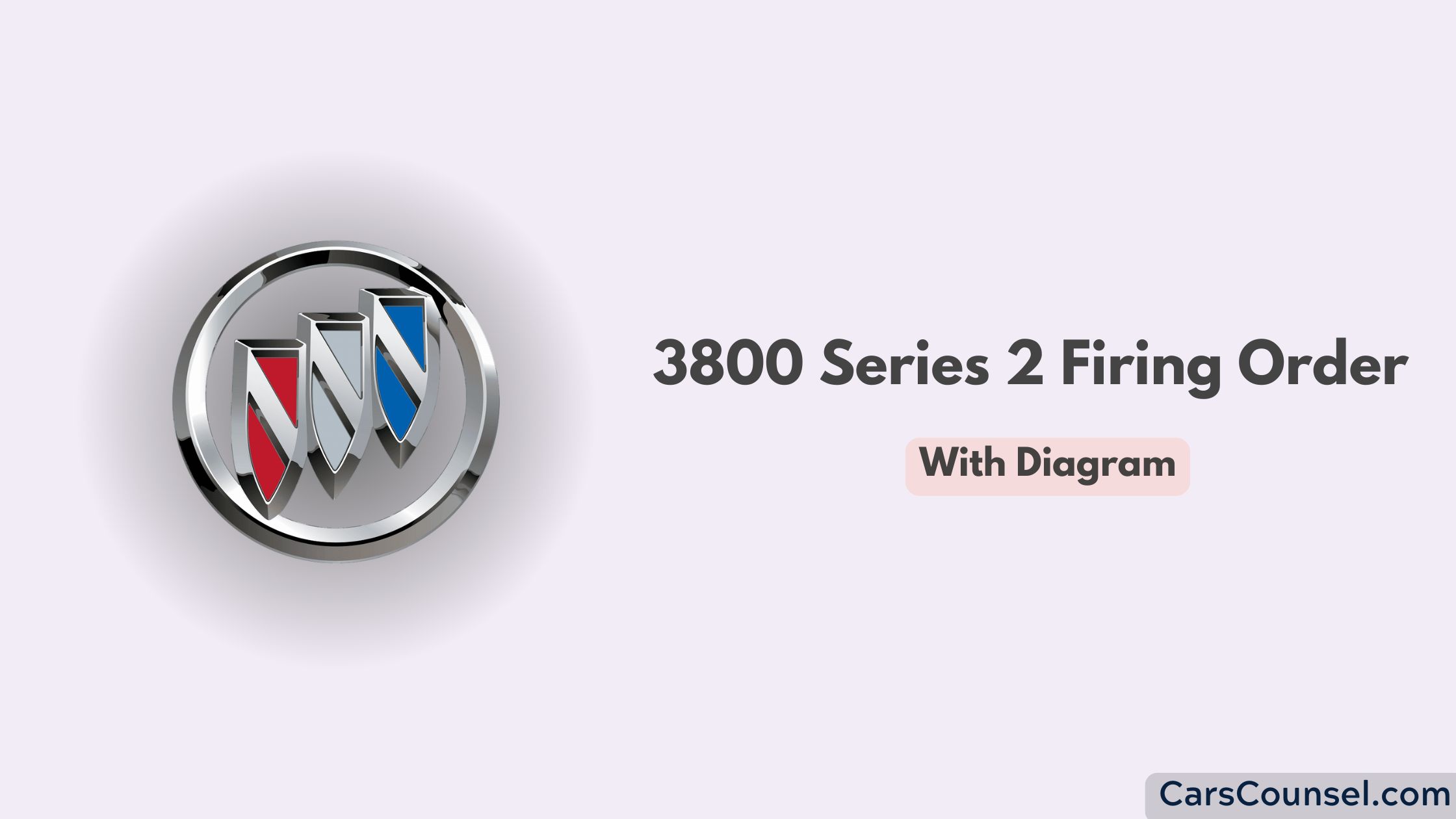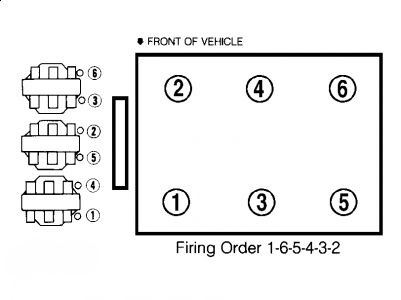The 3800 Series 2 engine, a staple in General Motors’ lineup, is widely praised for its durability, efficiency, and power.
Found in a variety of GM vehicles like the Buick Regal, Pontiac Grand Prix, and Chevrolet Impala, the 3.8L V6 engine was engineered for reliability and performance.
A key component of its operation is the firing order, a critical element that ensures smooth engine performance.
This guide explains the firing order for the 3800 Series 2 engine, its importance, and how it impacts the engine’s functionality. Whether you’re a DIY enthusiast, a mechanic, or simply curious about your engine, this article will provide you with a comprehensive understanding of the firing order and related troubleshooting tips.

Quick Navigation
The 3800 Series 2 Firing Order
The firing order for the 3800 Series 2 engine is: 1-6-5-4-3-2

How the Firing Order Works
- Cylinder 1 Fires First: The sequence begins with the frontmost cylinder on Bank 1.
- Cylinder 6 Fires Next: The rearmost cylinder on Bank 2 fires second.
- Cylinder 5 Fires Third: Ignition moves back to Bank 1 for the rear cylinder.
- Cylinder 4 Fires Fourth: The second cylinder on Bank 2 fires next.
- Cylinder 3 Fires Fifth: The middle cylinder on Bank 1 fires next.
- Cylinder 2 Fires Last: The second cylinder on Bank 2 completes the sequence.
This pattern alternates combustion between the two banks, ensuring smooth operation and balanced power delivery.
What Is a Firing Order?
The firing order refers to the sequence in which the engine’s spark plugs ignite the air-fuel mixture inside its cylinders. This sequence is carefully timed to ensure smooth and efficient power generation. The firing order is determined by the engine’s design and directly affects its performance.
Why Is the Firing Order Important?
- Smooth Operation: A correct firing sequence minimizes vibrations and ensures the engine runs smoothly.
- Efficiency: Proper timing allows complete combustion of the air-fuel mixture, optimizing fuel economy.
- Performance: Balanced power delivery ensures consistent acceleration and reliability.
- Longevity: A well-balanced firing order prevents unnecessary stress on engine components.
Overview of the 3800 Series 2 Engine
The 3800 Series 2 is a 3.8L V6 engine that features a 90-degree V-shaped cylinder arrangement. Known for its versatility and durability, it was used in both naturally aspirated and supercharged versions across many GM models from the mid-1990s to the late 2000s.
Engine Configuration
- V6 Layout: Six cylinders arranged in two banks of three, forming a “V” shape.
- Overhead Valve (OHV) Design: The engine uses pushrods to control the intake and exhaust valves.
- Cylinder Numbering:
- Bank 1 (closest to the radiator): Cylinders 1, 3, and 5.
- Bank 2 (closest to the firewall): Cylinders 2, 4, and 6.
Why GM Chose the 1-6-5-4-3-2 Firing Order
The 1-6-5-4-3-2 firing order is ideal for the 3800 Series 2 engine for several reasons:
- Balance: Alternating between banks reduces vibration and keeps the crankshaft’s motion smooth.
- Power Consistency: The sequence ensures a continuous flow of power, improving acceleration and driveability.
- Efficiency: Proper combustion timing optimizes airflow and fuel burn.
- Durability: Even distribution of combustion stresses helps prolong the life of internal components.
Identifying the Firing Order
Understanding how to verify and confirm the firing order is essential for maintenance and troubleshooting. Here’s how you can identify it:
Check the Owner’s Manual
The owner’s manual for your GM vehicle includes detailed specifications about the engine, including the firing order and cylinder numbering.
Inspect the Engine Block
Cylinder numbers are typically stamped on or near the intake manifold or ignition coils, making identification easier.
Use a Service Manual
Professional repair manuals provide diagrams and detailed explanations of the firing sequence and related components.
Symptoms of Incorrect Firing Order
An incorrect firing order can lead to significant engine performance issues. If the spark plugs fire out of sequence, you may notice the following problems:
Common Symptoms
- Engine Misfires: One or more cylinders fail to ignite correctly, causing rough performance.
- Rough Idling: The engine vibrates excessively or feels unstable when idle.
- Power Loss: Acceleration may become sluggish or inconsistent.
- Unusual Sounds: Knocking, pinging, or backfiring may occur.
- Increased Fuel Consumption: Inefficient combustion leads to higher fuel use and emissions.
Causes of Incorrect Firing Order
- Misconnected Spark Plug Wires: Plug wires connected to the wrong cylinders disrupt the firing sequence.
- Faulty Ignition Components: Worn spark plugs, ignition coils, or distributor caps can interfere with proper timing.
- Timing Chain Issues: A misaligned timing chain or gear can throw off the engine’s synchronization.
Diagnosing and Fixing Firing Order Problems
If you suspect firing order issues in your 3800 Series 2 engine, follow these steps to diagnose and resolve the problem:
Diagnostic Steps
- Inspect Spark Plug Wires: Ensure each wire is connected to the correct cylinder according to the 1-6-5-4-3-2 firing order.
- Check Ignition Components: Examine the spark plugs, ignition coils, and wires for wear or damage.
- Verify Timing Alignment: Use a timing light to ensure the timing chain or gear is aligned properly.
- Scan for Error Codes: Use an OBD-II scanner to detect misfire-related error codes.
Fixing Common Issues
- Reconnect Spark Plug Wires: Ensure the wires are routed to the correct cylinders.
- Replace Faulty Components: Replace worn spark plugs, ignition coils, or distributor caps as needed.
- Adjust Timing: If the timing chain or gear is out of alignment, realign it to factory specifications.
Preventative Maintenance for Firing Order Reliability
Maintaining the correct firing order is essential for ensuring the long-term performance of your 3800 Series 2 engine. Here are some preventative tips:
Regular Inspections
- Check spark plugs, ignition coils, and wiring for signs of wear or corrosion.
- Inspect the timing chain or gear for proper alignment and condition.
Replace Components as Needed
- Replace spark plugs and ignition coils at intervals recommended by GM.
- Use high-quality OEM components for compatibility and reliability.
Follow Maintenance Schedules
- Adhere to GM’s maintenance recommendations for regular inspections and part replacements.
FAQs About the 3800 Series 2 Firing Order
Can I Change the Firing Order?
No, the firing order is fixed based on the engine’s design and crankshaft configuration. Altering it would require extensive modifications.
What Happens If the Firing Order Is Incorrect?
An incorrect firing order can cause misfires, rough idling, power loss, and potential damage to engine components.
How Can I Verify the Firing Order?
Refer to the owner’s manual or a service manual. Diagnostic tools and cylinder markings can also help confirm proper ignition timing.
Is the Firing Order the Same for All V6 Engines?
No, while many V6 engines use similar firing orders, specific configurations can vary depending on the manufacturer and engine design.
Engines with Similar Firing Orders
- 2011 Buick Lacrosse Firing Order
- GM Firing Order
- 3800 Series 1 Firing Order
- Buick 455 Firing Order
- 2008 Buick Lacrosse Firing Order
Conclusion
The 1-6-5-4-3-2 firing order is a crucial part of the 3800 Series 2 engine, ensuring smooth operation, balanced power delivery, and efficient performance. By understanding and maintaining this firing order, you can keep your engine running reliably for years to come.
Whether you’re performing routine maintenance, diagnosing engine issues, or learning more about your engine, knowing the firing order is essential. With proper care and attention, your 3800 Series 2 engine will continue to deliver the dependable performance that GM’s V6 engines are known for

